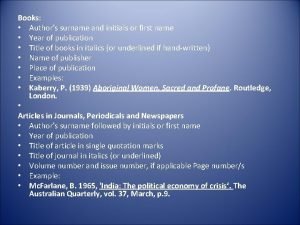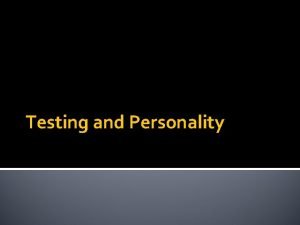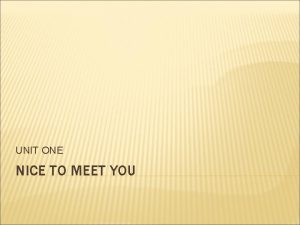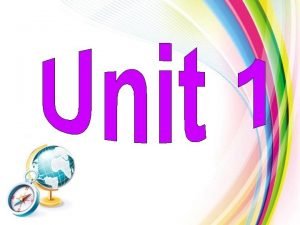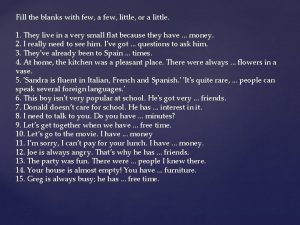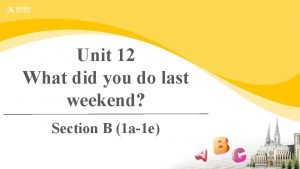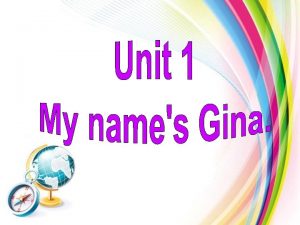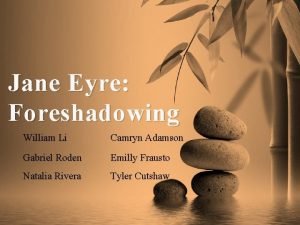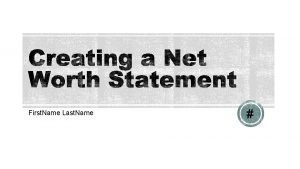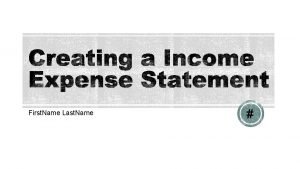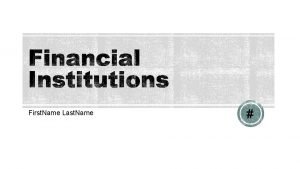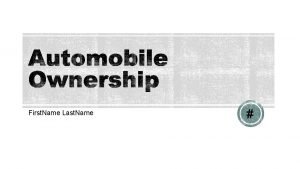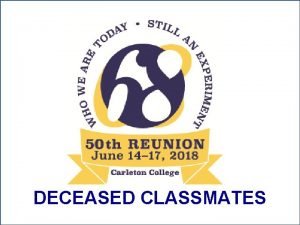Meet your classmates Presentation First and last name











- Slides: 11

Meet your classmates…. Presentation � First and last name � Age � Birthday � Favorite color � Number of brothers and sisters and where they are in birth order. � Hobbies/interests/sports � An interesting or surprising fact about them that not a lot of people know.

Unit 3 Review � With partner go over Unit 3 Vocabulary � Highlight what you don't know � Then go back over high lighted words in Unit 1 and Unit 2 making sure you still remember those hard ones.

Martha's Vineyard � If you could create a Deaf utopia, what would it look like? � Everyone would communicate in Sign Language, both deaf and hearing. Many, if not all children would be born deaf. � This actually was such a place once. It was an isolated island off the Massachusetts coast-Martha’s Vineyard. Some early Vineyard settlers carried a gene for deafness (the first known deaf one was Jonathan Lambert, 1694), and over years of marriage, generation after generation was born with hearing loss. � At one point, one in four children was born deaf. There were so many deaf people on the Vineyard (most deaf lived in Chilmark) that residents developed a sign language, Martha’s Vineyard Sign Language (MVSL) MVSL later merged with mainland signs to form ASL. � Sign Language was so accepted on the Vineyard that people moving to Chilmark had to learn sign language in order to live in the community. Deafness was majority and hearing actually thought it was contagious disease. Deafness in the town was never considered to be a handicap. The last Deaf Vineyard native passed away in 1950 s. It died down since most children would go away for college and schooling and then not come back.

The First Sign Language School In 1817, The American Sylum for Deaf-Mutes ( now the American School for the Deaf) was established in Harford, Connecticut. It became the first free public school for the deaf in America. Alice Cogswell was the first to enroll. With the two new colleagues at the helm, Gallaudet as principal and Clerc as head teacher, news of the school grew. Deaf people from all over the US were brought together for the first time. We know prior to this point, many deaf Americans were communicating through the constantly-evolving series of informal “home signs”. Asl stemmed from a combination of these signs, along with those of the FSL. In 1851, just days before Gallaudet death, he received an honorary Doctor of Laws degree from Ohio’s Western Reserve College. By 1863, there were twenty-two schools for the deaf in the US. Most of them were founded by Clerc students, both deaf and hearing, who had trained to become teachers. Today a bronze statue of Gallaudet and Cogswell resides on the Hartford campus, a reminder of ASL’s noble beginnings.

Higher Education � After Gallaudet’s death his sons continued his work. His eldest son and namesake, Thomas Gallaudet, founded New York’s Saint Ann’s Church for Deaf-Mutes in 1852. His brother, Edward Miner Gallaudet, became a teacher at their father’s school in Hartford. Edward had always wanted to establish a college for the deaf, but the considerable amount of funding required seemed impossible to achieve. � However in 1857, a wealthy philanthropist from Washington, DC donated a sizable amount of property to establish a residential school in the area. He asked Edward to be the superintendent. Edward took the school a step further, and in 1864 legislation was passed allowing the Columbia Institute to grant college degrees. The National Deaf-Mute College was the first ever college for the deaf. The school was later renamed the Gallaudet College in 1893. In 1891, the first formal training center for teachers of the deaf was established at the school. The school’s name changed once more in 1986 to Gallaudet University. A second statue of Gallaudet and Alice was build here, on the campus of the University. It depicts Alice next to Gallaudet on a chair as they share in the communication of “A” in Fingerspelling.

Fingerspelling Do’s and Don’ts? ? ? ? ? � Don’t Jerk, bounce, or move your hand. � Keep your elbow down, close to your side. � Hold your hand to the side of your chest, not in front of your face. Double letters? ? Double letters: Beginning or Middle � Don’t move your hand but make a quick repetition of the letter. For the letter A, your thumb doesn’t move but the rest of your fingers do. Words with the letter A, D, E, F, M, N, O, P, S, T. � Rather than making a letter repetition that doesn’t move, some letters require a double movement, as if you were fingerspelling a letter “on top” of the previous one. The letters B, C, G, K, L, P, R, U, X follow this pattern. Double letters: Ending � When double letters come at the end of a word, move your hand slightly to the right. This is the only time you’ll move your hand! Where to LOOK? ? ? Look at signer’s face area, around the chin area. Look at shape and movement pattern not individual letters (whole word rather than letters) TALL: bcfklruvw Down letters pq side letters gh moving letters jz

3 C’s � � � Context � Use clues based on context to narrow the word choice such as fruit, cars, states, animals, generational names, geographical location. � Look for restrictive clues (to narrow word possibilities even more): colors of rainbow, types of apples types of cars. Configuration � Look for the shape of the whole word rather than concentrating on each letter (same strategy we use for reading English) � Boxes Closure � Fill in the gaps � “u dnt ned se al thletrs to undrstnd”

Additional Strategies � Develop prediction skills (draw inferences) Using prediction skills will enable you to think ahead to what may be included. � Use background knowledge of the subject � Sound words out in syllabus � Also look at the length of the word, all of these strategies will assist � Most importantly, RELAX! You can always ask the person to sign in again. � Receptive fingerspelling practice websites � ALS � Fingerspell � You. Tube � Fingerspell WHEN? ? Persons Name, Name of a Place, for things for which there is no established sign.

FS Activity � Line up in ABC order by your last name. � Opposite cards ( Working on Receptive skills) � One person will FS a word off their card, the person with the opposite card will stand up and sign their word. The class will give thumbs up if right or thumb down if wrong.

Partner Activity � 1 st Partner: Your middle name? Your best friends name? Your childhood pet’s name? Your favorite relatives name? � 2 nd Partner Your mom’s name? Your dad’s name? Your siblings names? The name of the person you text the most? � 3 rd Partner Your favorite book? The car you would most like to own? Your favorite movie? Your favorite thing to eat?

Remind 101 � Signup for ASL 2
 First surname
First surname First name last name tpu
First name last name tpu Cettina fills out a personality
Cettina fills out a personality Your name what's your name
Your name what's your name A:nice to meet you b
A:nice to meet you b Hi good morning nice to meet you
Hi good morning nice to meet you Nice to meet you what's your name
Nice to meet you what's your name Until we meet again prayer
Until we meet again prayer I can’t find _____. does _____ steal it
I can’t find _____. does _____ steal it What did you do last week?.......in the pool.
What did you do last week?.......in the pool. How to introduce your friend to your teacher
How to introduce your friend to your teacher Classmates jane's nightmare
Classmates jane's nightmare
